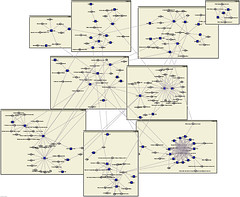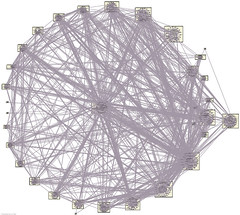December 25, 2007
Swedish Political Geometry
In time for Christmas we at Eudoxa presented Riksdagens Nštverk 2007, our report on the social networks of the Swedish parliament. The report is in Swedish, but here are some highlights:
Members of the ruling center-right coalition are co-authoring bills with each other across party lines to a great extent. However, the red-green former allies of the Social democrats are also networking with the coalition. Meanwhile the social democrats have not learned to network; as I pointed out last year they did not need to as long as they were in power, but now when they are opposition they seem to be content to raise issues internally. We'll see if that pays off - I'm doubtful.

Connecting members with co-authored bills produces a network with more structure (PDF file; a BIG network with the individual bills too can be found here). The size of the nodes denote betweenness centrality, color party membership.
Most MPs are in the giant component. Unlike last year the center-right alliance is not densely connected (since many proposals can be presented through the cabinet rather than as parliamentary bills), while the left and green parties remain fairly tight. Monica Green of the social democrats gets maximal centrality by being the only link between her isolated party and the rest. The moderate party, although "officially" the most conservative party, actually networks quite widely and becomes quite spread out.

Using Newmann's clustering algorithm finds a bunch of dense subnetworks beside the obvious social democratic network. One is composed of the political middle ground, the rest are various moderate clusters. One 3-person cluster is entirely separate and devoted to liberalizing alcohol sales. One mixed moderate-Christian democrat cluster is apparently the Swedish version of the Christian right. The remaining clusters appear to represent various special interests among the moderate party, like regional issues or alcohol policy.

Looking a the bills and members gives a more detailed overview where for example the Scania local issues, Stockholm issues and academic group become visible.

The social democrats have a rather complex internal cluster structure. I don't know enough about them to figure out who is who, but there is plenty of internal structure and working teams.
Similarly the other parties also have differently styled internal structures (Christian democrats, Center party, the liberal party, the green party, the left party). The greens seem to co-author intensely, probably regulated by a strong party whip. The left party appears to have functional groupings with heavy overlaps.
The center party, traditionally an agrarian countryside party with green tendencies has recently gained a more liberal/libertarian side. However, the network diagrams suggest that they network more outside their own party (including with the greens and the left) rather than into the party.
The most central bills were about internet security, freeing Dawit Isaak, human rights in Tibet, authorized guardian angels (protection for battered women), promoting companies with a social conscience, consumer policy and rules for castration of cats. That is, politically correct bills that nobody can be against.
The most central MPs were somewhat different from last year, but the greens and reds are still having the top bridge builders (beside Monica Green). Overall, they seem to realize the use of networking while the social democrats assume it is just numbers that will win the day (after next election).
Posted by Anders3 at December 25, 2007 08:57 PM